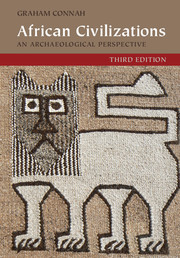Book contents
- Frontmatter
- Dedication
- Contents
- List of figures
- Preface and acknowledgements
- 1 The context
- 2 Origins: social change on the lower Nile
- 3 The Mediterranean frontier: North Africa
- 4 Sudanic genesis: Nubia
- 5 Isolation: the Ethiopian and Eritrean Highlands
- 6 Opportunity and constraint: the West African savanna
- 7 Achieving power: the West African forest and its fringes
- 8 Indian Ocean networks: the East African coast and islands
- 9 Cattle, ivory, and gold: social complexity in Zambezia
- 10 Central Africa: the Upemba Depression, Interlacustrine Region, and Far West
- 11 Settlement growth and emerging polities: South Africa
- 12 What are the common denominators?
- References
- Index
7 - Achieving power: the West African forest and its fringes
Published online by Cambridge University Press: 05 November 2015
- Frontmatter
- Dedication
- Contents
- List of figures
- Preface and acknowledgements
- 1 The context
- 2 Origins: social change on the lower Nile
- 3 The Mediterranean frontier: North Africa
- 4 Sudanic genesis: Nubia
- 5 Isolation: the Ethiopian and Eritrean Highlands
- 6 Opportunity and constraint: the West African savanna
- 7 Achieving power: the West African forest and its fringes
- 8 Indian Ocean networks: the East African coast and islands
- 9 Cattle, ivory, and gold: social complexity in Zambezia
- 10 Central Africa: the Upemba Depression, Interlacustrine Region, and Far West
- 11 Settlement growth and emerging polities: South Africa
- 12 What are the common denominators?
- References
- Index
Summary
In the second half of the fifteenth-century AD European sailors first set eyes on the southerly coast of West Africa. What they saw was hardly encouraging: from a distance, a vague grey line pencilled in between an immensity of sea and sky; from close-in, either a dangerous, surf-pounded, sandy beach or an uninviting network of mangrove swamp, creek, and river mouth. Whatever the character of the shoreline, however, behind it there was nearly always an impenetrable tangle of trees and other vegetation. Experience soon taught such visitors that this was a coast to be reckoned with: ships' crews died of fever, and shipworms (Teredo spp.) ate the bottoms out of their ships. Yet it was neither altruism nor curiosity that tempted most Europeans to such a region; it was profit. The very names they gave to different parts of this coast indicate their motives: ‘The Grain [pepper] Coast’, ‘The Ivory Coast’, ‘The Gold Coast’, ‘The Slave Coast’ (Bosman 1967: frontispiece map). Europeans quickly discovered that behind the coast lay a forested and savanna hinterland rich in resources, where the inhabitants were willing to trade on a considerable scale. Not only that, but those inhabitants lived in highly organized communities, some of which took on a size and density which left the visitors in no doubt about what they were dealing with. Within some parts of the West African forest and its fringes there were, indeed, hierarchical states, towns, and cities. Because of their conspicuousness, it was these large settlements that particularly attracted European attention. Thus, writing in AD 1507–8, the Portuguese Duarte Pacheco Pereira described Ijebu-Ode (now in Nigeria) as ‘a very large city’ (Bascom 1959: 38). In a similar vein, the Englishman Towerson, writing in 1557, could claim, perhaps with some exaggeration, that a town in what is now Ghana was ‘by the estimation of our men, as big in circuit as London’ (Blake 1942: vol. 2, 406).
These quotations are selected from early in the history of European West African contact, because state development and urbanization in the West African forest and its margins have sometimes been written about as if they were developments resulting from that contact rather than pre-dating it.
- Type
- Chapter
- Information
- African CivilizationsAn Archaeological Perspective, pp. 185 - 220Publisher: Cambridge University PressPrint publication year: 2015



